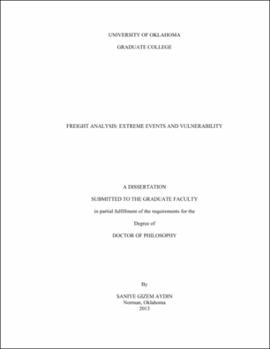| dc.contributor.advisor | Pulat, P. Simin | |
| dc.creator | Aydin, S. Gizem | |
| dc.date.accessioned | 2019-06-03T20:36:15Z | |
| dc.date.available | 2019-06-03T20:36:15Z | |
| dc.date.issued | 2013 | |
| dc.identifier | 99242402802042 | |
| dc.identifier.uri | https://hdl.handle.net/11244/320240 | |
| dc.description.abstract | Freight transportation plays a vital role in our everyday lives as individuals, in business, and society as a whole. However, when compared to passenger transportation, the research focus on freight transportation is relatively young. This dissertation is a collection of published papers, aimed to build, develop and improve knowledge regarding freight transportation. | |
| dc.description.abstract | The dissertation specifically develops a framework to analyze freight transportation under extreme event conditions and investigates the vulnerability concept for the freight transportation system. First, we present the role of freight flow in the U.S. and other countries. Further, we decompose the freight transportation flow into four types: from, to, within, and through flows and analyze the flow at different geographic levels, such as at the state, regional, or Metropolitan Statistical Area (MSA) level. Using a linear regression model, we show that the decomposed freight flows can be linked to major socio-economic indicators, such as employment, revenue, income, and payroll. The regression model is illustrated at county level for the state of Oklahoma by disaggregating its MSAs, and at state level for the rest of the country. [Paper I]. | |
| dc.description.abstract | The research shows that transportation system failures are, more often than not, fail due to extreme events such as man-made or natural disasters. As a result of the impacts from such disasters, the movement of freight changes. We analyze the I-40 Bridge collapse in Oklahoma of 2002, using two approaches. The first approach assigns the origin-destination freight flow to the network with the collapsed bridge removed. The second approach involves two successive assignments - first, by excluding the pre-hazard freight flow on the bridge and assigning the rest of the flow to the post disaster network; and second, by assigning the freight flow on the bridge in pre-disaster conditions to the post-disaster-network. We show that the approaches represent two different objectives: (1) the immediate disaster response is planned or (2) the focus is on re-routing strategies. Once the objective is chosen, we can model the affect of an extreme event on freight movement. We additionally show that the models relying on the gravity-based spatial distance decay effects often overestimate the nearby freight flow changes while underestimating the further-out changes in the network [Paper II]. Furthermore, by developing a framework, we generalize the analysis of an extreme event impact on the freight flow and demonstrate that any extreme event can be analyzed by focusing on the "crippled" segment of the network while considering the effects of increased travel distances, time, cost, and, supply-demand changes following an extreme event. Alternative re-routing options and the impact of repair strategies are also discussed [Paper III]. | |
| dc.description.abstract | In addition to the impact of the extreme events on freight flow, the dissertation investigates the reason behind the failures by defining and measuring the vulnerability of freight transportation systems. We define vulnerability based on the characteristics of freight systems; we specifically use multimodal freight systems to develop the concept and discuss risk and reliability. The characteristics of the multimodal freight system are inherently dynamic and also dependent on one another, as well as on other systems. We integrate not only the network (topological) but also temporal and geographic characteristics to model the freight transportation vulnerability [Paper IV]. Finally, we develop a methodology integrating graph theoretical measures and multi-attribute value theory. We illustrate the methodology with a case study of Hurricane Katrina of 2005, show how the network and freight flow attributes are used in identifying the vulnerability of freight. | |
| dc.format.extent | 159 pages | |
| dc.format.medium | application.pdf | |
| dc.language | en_US | |
| dc.relation.requires | Adobe Acrobat Reader | |
| dc.subject | Freight and freightage | |
| dc.title | Freight Analysis: Extreme Events and Vulnerability | |
| dc.type | text | |
| dc.type | document | |
| dc.thesis.degree | Ph.D. | |
| ou.group | College of Engineering::School of Industrial Engineering | |
